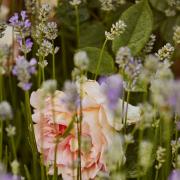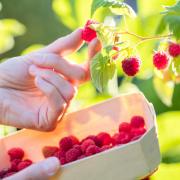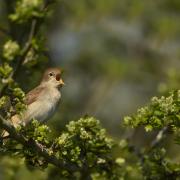March signals the start of spring and the promise of warmer days to come as plants start to emerge from their slumber. Slowly, sleepily at first, the sunshine persuades the lesser celandine to emerge in bright yellow splashes. Around the ponds here at RSPB Pagham Harbour, marsh marigolds bloom an intense and bold yellow, while primroses reveal themselves with a subtler hue. As temperatures rise, spring gathers momentum. blackthorn bushes burst with white blossom, the catkins of hazel trees sway in the breeze, and the air around the goat willows hum with the sound of spring’s first insects taking advantage of this early source of nectar and pollen.
Having spent the winter hibernating, queen bumblebees zig-zag low over the ground, searching for old mouse or vole burrows to make their nests in and Peacock, Brimstone and Comma butterflies are enticed out by the sun.

Resident birds that stay with us all year round now start to find a mate and begin rearing a family. Robins have been holding territories all winter and are quick to attack any rivals entering their patch. If you see two robins happy in each other’s presence, it’s likely they’re a pair. Blue Tits and Great Tits can be seen prospecting nest boxes and cavities for their favoured des-res.
Bird species that visit Pagham Harbour for the winter have now left. The constant honking dialogue of Brent Geese and whistling of Wigeon ducks has faded and a silence has fallen across the saltmarsh, broken occasionally by the alarm calls of Curlew and Redshank. However, the harbour won’t be quiet for long as summer visitors are on their way. Wheatears are touching down now and can be found along the shingle beaches and in open farmland across Pagham Harbour and Medmerry. The males have a grey crown and back, black wings and an orange flush to the breast. Sporting a black patch through its eye and a white stripe above, it flashes its white rump as it flies ahead.
The smallest of the swallows and martins, the Sand Martin, is close behind and like the Wheatear has spent the winter in Africa. Its upperparts are brown and underparts white, with a distinct brown band across its chest. They zoom through the skies, fast and agile on pointed wings, catching insects over open fields and water. Sand Martins nest in colonies, digging burrows up to a metre long in sandy cliffs usually along rivers and over open water courses.

Chiffchaffs arrive now too, although with milder winters some do stay with us all year round, but the majority arrive in spring. Flitting through the trees and hedgerows, they have an olive-brown back and dull yellowish underparts. Their voice is the easiest way to recognise them as they call their name ‘chiff-chaff, chiff-chaff’, over and over, as consistently as a metronome.
Next month another special bird will be arriving and on a sunny spring morning I like to sit on the beach at Church Norton, look out to sea and wait. There. Just a dot but getting bigger as it comes closer. Racing over the waves, before ‘whoosh’ over my head and beyond. Swallows, arriving before my eyes, back to spend the summer with us. Their long tail-streamers and reddish-brown faces help to distinguish them from martins and their upperparts are an iridescent blue-black. It’s a joy to watch these speedy little rockets coming in off the ocean.
To find out more about visiting RSPB Pagham Harbour, go to www.rspb.org.uk/PaghamHarbour



























